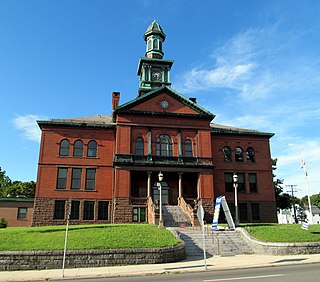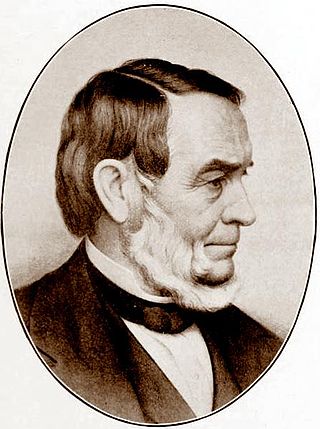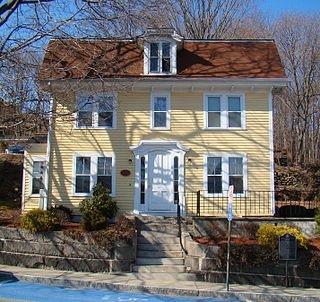Related Research Articles

Windham County is one of the eight historical counties in the U.S. state of Connecticut, located in its northeastern corner. As of the 2020 census, the population was 116,418, making it the least populous county in Connecticut. It forms the core of the region known as the Quiet Corner. Windham County is included in the Worcester, MA-CT Metropolitan Statistical Area, which is also included in the Boston-Worcester-Providence, MA-RI-NH-CT Combined Statistical Area. The entire county is within the Quinebaug and Shetucket Rivers Valley National Heritage Corridor, as designated by the National Park Service.

Brooklyn is a town in Windham County, Connecticut, United States. The town is part of the Northeastern Connecticut Planning Region. The population was 8,450 at the 2020 census. The town center village is listed by the U.S. Census Bureau as a census-designated place. The district of East Brooklyn is listed as a separate census-designated place.

Canterbury is a town in Windham County, Connecticut, United States. The town is part of the Northeastern Connecticut Planning Region. The population was 5,045 at the 2020 census.

Plainfield is a town in Windham County, Connecticut, United States. The town is part of the Northeastern Connecticut Planning Region. The population was 14,973 at the 2020 census. The town comprises four villages: Plainfield, Moosup, Wauregan, and Central Village. Each village has their own respective United States Post Office and fire department. The entire town is serviced by the 860 area code.

David Daggett was a U.S. senator, mayor of New Haven, Connecticut, Judge of the Connecticut Supreme Court of Errors, and a founder of the Yale Law School. He helped block plans for the first college for African Americans in the United States and presided over the conviction of a woman running a boarding school for African Americans in violation of Connecticut's recently passed Black Law. He judged African Americans not to be citizens and supported their colonization to Africa.

Prudence Crandall was an American schoolteacher and activist. She ran the Canterbury Female Boarding School in Canterbury, Connecticut, which became the first school for black girls in the United States.

Samuel Joseph May was an American reformer during the nineteenth century who championed education, women's rights, and abolition of slavery. May argued on behalf of all working people that the rights of humanity were more important than the rights of property, and advocated for minimum wages and legal limitations on the amassing of wealth.

Northeastern Connecticut, better known as the Quiet Corner, is a historic region of the state of Connecticut, located in the northeastern corner of the state. No official definition exists; the term is generally associated with Windham County, but also sometimes incorporates eastern sections of Tolland County and the northern portion of New London County.

The Canterbury Center Historic District is a historic district in Canterbury, Connecticut. The district is centered on the town green, located at the junction of Route 169 and Route 14. It has been the town center since 1705, and includes a fine assortment of 18th and early 19th-century architecture. It was listed on the National Register of Historic Places (NRHP) in 1998.

The Prudence Crandall Museum is a historic house museum, sometimes called the Elisha Payne House for its previous owner. It is located on the southwest corner of the junction of Connecticut Routes 14 and 169, on the Canterbury, Connecticut village green. It is designated a U.S. National Historic Landmark as Prudence Crandall House.

The Central Village Historic District is a historic district in the Central Village area of Plainfield, Connecticut, United States that was listed on the National Register of Historic Places (NRHP) in 1991. It encompasses a late 19th-century historic mill village, including a small commercial center where Connecticut Route 12 and 14 meet, a cluster of architecturally distinguished buildings built by mill owners and managers, and a collection of mill worker housing units. It includes the Plainfield Woolen Company Mill, which is separately listed, as well as archaeological remnants of other mill infrastructure. It also includes Plainfield's old town hall and high school. Other architecturally prominent buildings include the c. 1855 Italianate mansion of mill owner Arthur Fenner, and the 1845 Greek Revival Congregational Church.
Andrew Thompson Judson was a United States representative from Connecticut and a United States district judge of the United States District Court for the District of Connecticut. He also served in the Connecticut House of Representatives. He was a member of the Toleration Party and an officer of the American Colonization Society. A leading white supremacist, he led opposition to Prudence Crandall's school for African Americans in Connecticut and advocated for African Americans to be subjugated or sent to Africa. He also opposed the establishment of a college for African Americans in New Haven. As a judge in the United States v. The Amistad he ruled the enslaved captives aboard La Amistad be released and returned to Africa.

The Jail Hill Historic District encompasses a 19th-century working-class residential district in Norwich, Connecticut. Located on a steep hill overlooking downtown Norwich, it was populated first by African Americans, and then by Irish immigrants. Some early African-American residents played significant roles in bringing expanded rights and education to others. The district was added to the National Register of Historic Places on April 19, 1999.

The Oneida Institute was a short-lived (1827–1843) but highly influential school that was a national leader in the emerging abolitionist movement. It was the most radical school in the country, the first at which black men were just as welcome as whites. "Oneida was the seed of Lane Seminary, Western Reserve College, Oberlin and Knox colleges."
Julia Ward Williams Garnet was an American abolitionist who was active in Massachusetts and New York.

Ebenezer Pemberton was an American educator and 2nd Principal of Phillips Academy Andover from 1786 to 1793. Refusing to follow his uncle's wishes to become a clergyman, Pemberton pursued a teaching career that would become his life's work. After graduating from Princeton University, he served terms as principal of a number of schools for early education including Plainfield Academy in Plainfield, Connecticut, Phillips Academy, and his own Pemberton Academy in Billerica, Massachusetts. He founded another school in 1810 in Boston, serving as principal there until poor health forced him to retire.

The Canterbury Female Boarding School, in Canterbury, Connecticut, was operated by its founder, Prudence Crandall, from 1831 to 1834. When townspeople would not allow African-American girls to enroll, Crandall decided to turn it into a school for African-American girls only, the first such in the United States. The Connecticut legislature passed a law against it, and Crandall was arrested and spent a night in jail, bringing national publicity. Community violence forced Crandall to close the school.
The Phoenix Society, was a mutual aid society for African Americans and education, "an organization dedicated to 'morals, literature and the mechanical arts'". It was founded in 1833 by Samuel Cornish, Theodore Wright, Peter Williams Jr., and Christopher Rush in New York City. They had support from the philanthropist brothers Arthur and Lewis Tappan. Many people associated with the Phoenix Society attended the New York Manumission Society’s African Free School in New York City.
Reuben Crandall, younger brother of educator Prudence Crandall, was a physician who was arrested in Washington, D.C., on August 10, 1835, on charges of "seditious libel and inciting slaves and free blacks to revolt", the libels being abolitionist materials portraying American slavery as cruel and sinful. He was nearly killed by a mob that wanted to hang him, and avoided that fate only because the mayor called out the militia. The Snow Riot ensued. Although a jury would find him innocent of all charges, his very high bail meant he remained in the Washington jail for almost eight months, where he contracted tuberculosis. He died soon after his release.
Ann Eliza Hammond was an African American student from Providence, Rhode Island. She attended Prudence Crandall's Canterbury Female Boarding School and was subpoenaed and arrested in 1833 for vagrancy as a result of Connecticut opposition to the school's attempt at desegregation. Her father, Thomas Hammond, had died in 1826.
References
- ↑ "Old Academy, Plainfield, Windham County, CT". Library of Congress.
- ↑ "Plainfield Academy: Grooming Connecticut Scholars in the 18th and 19th Centuries | Connecticut History | a CTHumanities Project". 22 July 2022.
- 1 2 3 4 Williams, Donald E. Jr. (June 3, 2014). Prudence Crandall's Legacy: The Fight for Equality in the 1830s, Dred Scott, and Brown v. Board of Education. Wesleyan University Press. ISBN 9780819574718 – via Google Books.
- 1 2 Lincoln, Allen B. (November 30, 1920). "A Modern History of Windham County, Connecticut: A Windham County Treasure Book". S. J. Clarke Publishing Company – via Google Books.
- 1 2 Larned, Ellen Douglas (1880). "History of Windham County, Connecticut: 1760-1880".
- 1 2 Williams, Donald E. (2014-06-03). Prudence Crandall's Legacy: The Fight for Equality in the 1830s, Dred Scott, and Brown v. Board of Education. ISBN 9780819574718.
- ↑ Douglas, Charles Henry (1917). "The Government of the People in the State of Connecticut".